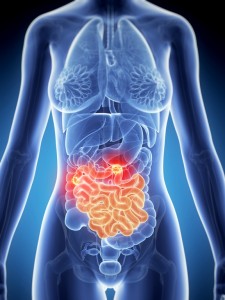Introduction
First of all, here is a description of the digestive system and gastrointestinal disorders. This covers a large area of what the physician encounters in everyday practice.
The digestive system (gastrointestinal tract) starts in the mouth and ends at the anal opening. Food travels from the mouth, where we chew it via the esophagus into the stomach. There acid and pepsin enzymes start digesting carbohydrates (sugar and starch). The food travels into the small intestine, which consists of the three sections called duodenum, jejunum and ileum. The remaining food transitions at the ileocecal valve into the colon and finally into the rectum.
Digestion of food
In the duodenum bile salts and pancreatic juices join the bowel content, which helps digesting fat and protein. The jejunum and ileum absorb nutrients and vitamins including vit. B12. The colon’s job is to reabsorb water and retain minerals. In addition, the left over, leached out material prepares to become stool. The rectum is the last storage chamber and it absorbs water from stool. Stool is expelled as a bowel movement from time to time. The stool gets its final shape from the anal canal.
Three important organs are connected to the digestive system: the gall bladder, the pancreas and the liver. I mentioned above how the gallbladder and pancreas function. The liver is the main metabolic organ of the body. It receives nutrients via the veins from the small intestine, which form the portal vein system. Through this the liver gets all of its nutrients.
Absorption of nutrients
Next, th liver absorbs the building blocks of fatty acids, amino acids and sugar molecules. The liver modifies them to fit the body’s needs. The blood vessels connect the liver to the rest of the body. This way the nutrients can reach all of the body’s tissues. This is how the muscles can build up muscle mass. The brain gets glucose to think and all of the body cells maintain their metabolism.
In the following I will describe diseases of the digestive system. I will also mention what can be done from a medical point of view to help cure or at least alleviate the conditions.







